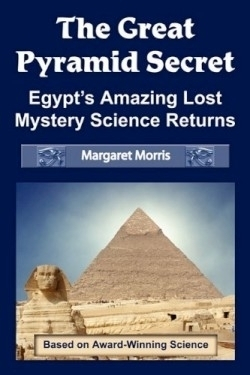The Great Pyramid Secret
Egypt's Amazing Lost Mystery Science Returns
Regardless of the countless scholars worldwide who have proposed theories on how the ancient Egyptian pyramids were constructed, doubt remains the overriding force in this fascinating field of archaeological architecture. Though experts describe possible methods in convincing detail, some disbelievers refuse to accept textbook analysis and prefer to seek farfetched answers on the bottom of the ocean in the lost continent of Atlantis or in the depths of space where aliens who once visited Earth may reside.
Margaret Morris asserts that widespread disbelief of the feasibility of dragging, hoisting, and carving to absolute perfection each and every piece of the pyramids has caused ongoing speculation. If current ideas do not make sense, then people search for alternative views, some of which may be ludicrous. Morris claims that researchers who have attempted to prove a haul-and-lift method of construction have failed. In a common-sense, practical manner, she proposes a new theory, a recovered technology based on geopolymerization, which may be easier to accept than past explanations that cannot abolish warranted skepticism.
Methodical and organized, Morris presents her ideas to the academic community as well as to casual readers interested in pursuing Egyptian archaeological science for entertainment alone. She does not gloss over any aspect of her hypothesis that might be difficult to back with facts; instead, she supports her statements with even greater evidence. She does not come across as a scientist looking for shock value recognition. She believes the pyramids were built using a simple, but sophisticated, Late Stone Age technology. Then essential natural resources eventually ran out, and the process went into decline.
Morris began her study of Egyptian architecture and antiquities at Barry University’s former Institute for Applied Archaeological Sciences and later served as the institute’s assistant director. Since 1984 she has written books and published articles in science and technical journals such as The Journal of Geological Education. Her award-winning colleague, Dr. Joseph Davidovits, founder of the chemistry of geopolymerization, has collaborated with her. Their co-authored book introduced this recovered ancient technology to a diverse group of readers in 1988.
Though scientific controversy may continue into the indefinite future, Morris has presented a logical “solution” to the pyramid puzzle. Debate thrives on unproven theories, and since no one can be one hundred percent certain of what construction methods were employed without traveling back in time, the discussion will most likely not end with this book or any future text on the pyramid mystery.
Reviewed by
Julia Ann Charpentier
Disclosure: This article is not an endorsement, but a review. The publisher of this book provided free copies of the book and paid a small fee to have their book reviewed by a professional reviewer. Foreword Reviews and Clarion Reviews make no guarantee that the publisher will receive a positive review. Foreword Magazine, Inc. is disclosing this in accordance with the Federal Trade Commission’s 16 CFR, Part 255.

